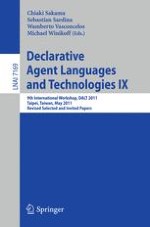2012 | Buch
Declarative Agent Languages and Technologies IX
9th International Workshop, DALT 2011, Taipei, Taiwan, May 3, 2011, Revised Selected and Invited Papers
herausgegeben von: Chiaki Sakama, Sebastian Sardina, Wamberto Vasconcelos, Michael Winikoff
Verlag: Springer Berlin Heidelberg
Buchreihe : Lecture Notes in Computer Science
